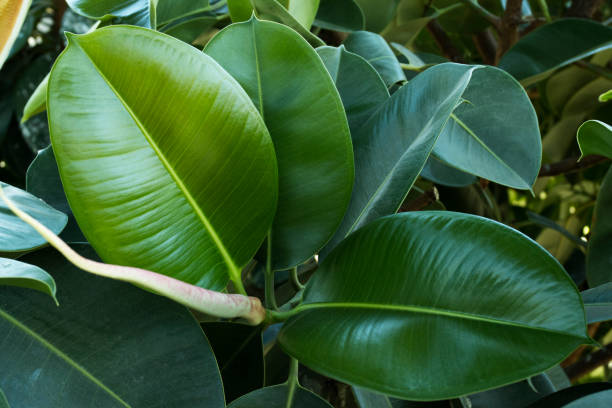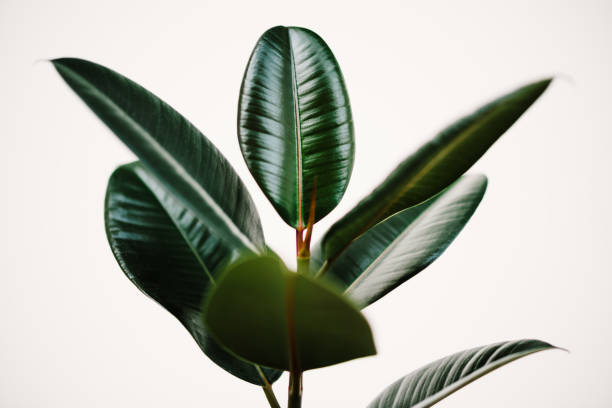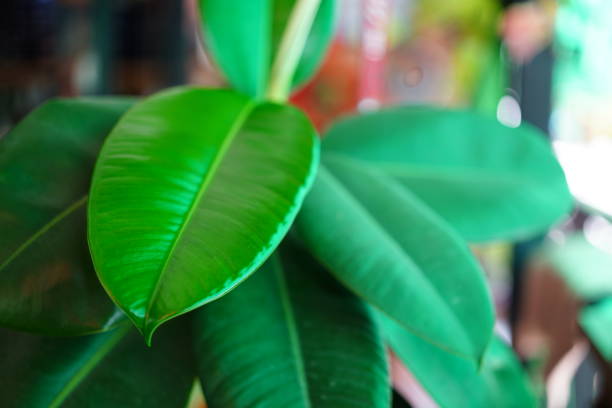
Welcome to our comprehensive guide on growing and caring for rubber tree plants (Ficus elastica). If you’ve ever encountered a rubber tree with its incredible beauty and unique foliage, you understand the fascination it evokes. Its large, waxy leaves in variegated green and white, burgundy, or even nearly black colors are so visually stunning that you may mistake them for artificial creations. However, we assure you that rubber trees are real living plants that can thrive both indoors and outdoors in warm climates.
In this guide, we will provide you with all the information you need to successfully grow and care for rubber tree plants. From cultivation and propagation to essential growing tips, pruning techniques, and pest management, we’ve got you covered. Let’s dive in!
Cultivation and History
Rubber trees (Ficus elastica) are native to the tropical forests between India and Indonesia. In their natural habitat, these trees can reach heights of over 100 feet, creating shelter for animals and humans alike. Historically, rubber trees served two significant purposes in the region.
First, the latex or milky sap that bleeds from the bark when punctured was tapped and processed to produce rubber. However, this type of rubber has been largely replaced by the rubber tree species H. brasiliensis, which is easier to tap and yields more sap. It’s important to note that the sap of rubber trees can cause skin irritation and is toxic to pets.
Secondly, rubber trees were used to create living bridges. By training the roots of these trees to grow along fallen logs placed across ravines and rivers, people constructed remarkable bridges that lasted for centuries. The extensive and flexible roots of rubber trees allowed them to thrive and support these incredible structures.
While rubber trees have such fascinating historical uses, it’s their beauty and resilience that have made them popular houseplants and ornamental trees worldwide. With their low maintenance requirements, shade-loving tendencies, and easy propagation, rubber trees have become a favorite choice for indoor and outdoor decoration.
Propagation

Propagating rubber trees is remarkably easy, thanks to their natural ability to root and grow from cuttings. Starting with a young plant is recommended to allow it to acclimate to its new environment. When handling cuttings or piercing the bark, it’s essential to protect your skin and prevent contact with the sap, as it can irritate. Gloves and sharp, clean tools are necessary for successful propagation.
Propagation from Cuttings: If you know someone with a rubber tree, you can ask for a cutting when they prune the plant. The best time to take cuttings is in late spring or early summer when the plant is actively growing. A six-inch long cutting with at least three to four leaf nodes is ideal for propagation.
There are two methods to propagate a new plant from the cutting. The first method involves dipping the open end of the cutting in a powdered rooting hormone and placing it in water. Keep the cutting near a sunny window but away from direct sunlight, and allow it time to root.
The second method, which is highly successful, is to strip all but one leaf off the cutting. Carefully avoid touching the sap that oozes from each leaf node. Prepare a pot with a mixture of potting soil, sand, and peat moss, and moisten it thoroughly. Loosely press the cutting into the soil, wrap it and the pot with a clear plastic bag, and place it in a sunny location with indirect sunlight. Maintain humidity by occasionally opening the plastic and checking the moisture level. Rooting can take three to six weeks, and once roots have formed, transplant the cutting into a larger pot with a potting soil and peat moss blend.
Air Layering: Another method of propagation is air layering, which results in a plant with a stronger root system that remains attached to the parent plant. Choose a healthy branch with a few leaves and create a wound between two leaf nodes. Apply rooting hormone powder to the exposed xylem and wrap damp sphagnum moss or coconut coir around the wound. Cover it with plastic, ensuring moisture retention. Once roots have developed, cut the branch free from the parent and plant the rooted cutting in a pot.
How to Grow

Rubber trees are known for their low maintenance requirements and resilience. Here are some key tips to help you grow healthy and thriving rubber tree plants:
1. Potting Mix: Use a well-draining potting mix consisting of potting soil, coconut coir, and peat moss. This blend ensures good aeration and prevents waterlogging.
2. Watering: Rubber trees are drought-tolerant and should be watered sparingly during the dormant months, such as winter. When the plant is actively growing in spring and summer, increase watering but avoid overwatering. Too much water can lead to root rot and leaf drooping. Always check the soil moisture level before watering and ensure it is slightly dry before the next watering.
3. Sunlight: Rubber trees thrive in bright, indirect sunlight. Avoid placing them in direct sunlight, which can scorch the leaves. If you notice wilting or discolored leaves, it may indicate a need for more sunlight. Gradually introduce the plant to brighter conditions, but always shield it from direct sunlight.
4. Fertilization: Use a liquid fertilizer formulated for tropical plants during the spring or summer if necessary. Follow the package instructions for application rates and frequency. Fertilizing during the active growth period will support healthy foliage development.
5. Humidity: Rubber trees appreciate higher humidity levels, mimicking their native tropical environment. Increase humidity by misting the leaves a couple of times per month, especially in winter when indoor heating can dry the air. Alternatively, wipe the leaves with a damp cloth to remove dust and maintain moisture levels.
6. Repotting: Check the roots regularly to ensure they are not becoming root-bound or girdling. If the roots are compacted or taking up most of the available space in the pot, it’s time to repot. Choose a pot that is slightly larger and has adequate drainage. Gently separate the root system, remove any dead or decaying roots, and transplant the plant into the new pot with fresh potting mix.
7. Outdoor Growing: Rubber trees can be moved outdoors if temperatures consistently stay above 50°F. Place the plant in a protected area with indirect sunlight. In USDA Hardiness Zones 9-11, rubber trees can be grown outdoors year-round, but be cautious of their rapid growth and potential invasiveness. Avoid planting them near sidewalks or foundations, as their strong roots can cause damage.
Pruning and Maintenance

Proper pruning is essential for controlling the growth and maintaining the desired size and shape of your rubber tree. Regular pruning also helps remove any damaged or diseased parts of the plant. Here are some guidelines for pruning and maintenance:
1. Pruning Techniques: When pruning your rubber tree, always have a rag handy to control the sap that bleeds out. Wear gloves to protect your hands and prevent contact with the sap, as it can stain surfaces and cause skin irritation. Use clean pruning shears or a garden knife to trim the branches while maintaining the shape and size of the tree. Avoid cutting more than necessary to prevent shock and leaf drop.
2. Cleaning and Maintenance: Periodically wipe the leaves with a damp cloth to remove dust and improve the plant’s appearance. Remove any dead or dying foliage to maintain plant health. If you observe signs of infestation or disease, address them promptly using appropriate pest control or treatment methods.
Cultivars to Select
Rubber trees offer various cultivars with unique colors and patterns, adding a touch of elegance to your indoor space. Here are some popular cultivars to consider:
- Burgundy: This cultivar showcases stunning colors, ranging from deep green and burgundy to almost black, with red midribs and scarlet-sheathed new growth.
- Decora: ‘Decora’ features variegated leaves with green and white patterns and red midribs. Its vibrant coloration often makes it a top choice for artificial rubber tree replicas.
- Doescheri: ‘Doescheri’ is a variegated variety with leaves exhibiting creamy white, bright green, army gray, and yellow shades, mottled together with striking pink margins.
- Robusta: This cultivar closely resembles the true species plant, characterized by wide, waxy, and bright green leaves. Its structured growth habit adds a tropical touch to any space.
- Ruby: ‘Ruby’ stands out with its unique coloration. The upper side of the leaves ranges from deep green to burgundy, while the lower side showcases shades of pink to deep burgundy. The branches and trunk can display a bright green color, maturing to deeper green or brown.
- Tineke: Another variegated cultivar, ‘Tineke,’ exhibits pink to burgundy midribs, sprouts, and leaf margins, adding a touch of elegance to any indoor setting.
- Tricolor: Young plants of the ‘Tricolor’ variety boast variegated cream and white leaves with splotches of pink to orange, gradually transitioning to green and cream as they mature.
Managing Pests and Disease

While rubber trees are generally resistant to pests and diseases, occasional infestations or infections can occur. Here are some common pests and diseases to be aware of and their respective management techniques:
1. Insects:
- Aphids: Control aphids by spraying the plant with insecticidal soap or wiping the leaves with a damp cloth soaked in insecticidal soap. Repeat as necessary until the infestation is eliminated.
- Mealybugs: Use rubbing alcohol to remove mealybugs from the leaves, and follow up with insecticidal spray or neem oil treatments every two to three weeks.
- Scale Insects: Apply neem or horticultural oil to the leaves, ensuring thorough coverage of both sides. Treat affected areas repeatedly if necessary.
- Spider Mites: Combat spider mites by spraying the plant with water or using an insecticidal soap. Ensure thorough coverage, including the undersides of leaves.
2. Nematodes: Foliar nematodes may harm rubber trees, but infestations are rare. Unfortunately, there is no known treatment for foliar nematodes, and affected plants are typically beyond saving. Early detection is crucial.
By following these guidelines for growing, pruning, and managing pests, you can ensure your rubber tree plants remain healthy and vibrant, adding a touch of natural beauty to your surroundings.
Conclusion
In conclusion, rubber tree plants (Ficus elastica) are stunning tropical houseplants that bring elegance and beauty to any indoor or outdoor space. With their large, waxy leaves in a variety of colors, such as variegated green and white, burgundy, and nearly black, these plants are visually captivating.
Rubber trees are relatively low maintenance and resilient, making them suitable for both beginner and experienced plant enthusiasts. They prefer bright, indirect sunlight and should be watered sparingly, allowing the soil to dry out slightly between waterings. A well-draining potting mix
Rubber tree plants are a wonderful addition to any plant collection, bringing a tropical vibe and adding elegance to your home or garden. By following the care guidelines provided and observing your plant’s specific needs, you can enjoy the beauty and resilience of rubber trees for years to come.






